Nemophila: types, rules of planting and care

Anyone who has seen a nemophila bloom at least once in his life will never forget this amazing sight and will definitely plant a plant on his site. Due to the pale blue, spotted and dark purple flowers with a characteristic center in a contrasting color, Nemophila is in great demand among homeowners and landscape designers. Let's take a look at the types, planting rules and plant care.
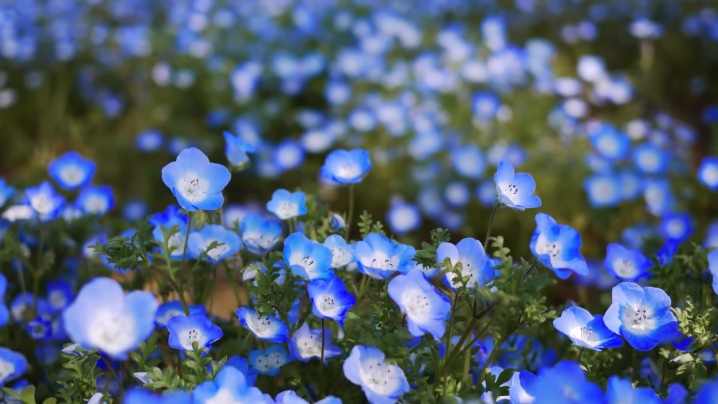
Description
Nemophila (from Lat. Nemophila) is a genus of herbaceous plants belonging to the Aquifolia family and grows in the western and southeastern United States, Mexico and Canada. The plant is well known to fans of decorative flowers all over the world and is successfully cultivated in most countries. In the English-speaking society, the genus is called nothing more than baby blue-eyes ("Baby blue eyes"), which translated into Russian means "blue eyes of a child." In Russia, nemophila is better known as "American forget-me-not." People in Japan also have great sympathy for the flower and boast Hitachi Park, which grows about 4.5 million copies of nemophila.
American forget-me-not is an annual spring-flowering plant with creeping stems up to 30 cm high. The flower belongs to the category of ground cover plants, has bright green pinnate-lobed leaves and five-petal flowers with a diameter of 2-4.5 cm. At the end of flowering, the plant produces smooth or wrinkled seeds with a characteristic ovoid shape.
Like any ground cover species, Nemophila covers the ground with a solid carpet during flowering, which makes it perfect for decorating very large areas, such as hillsides and natural parks.
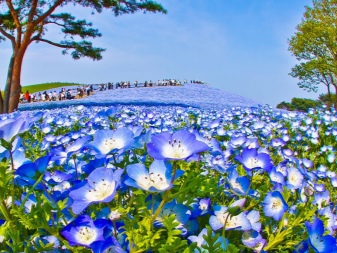
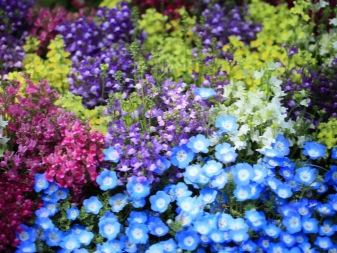
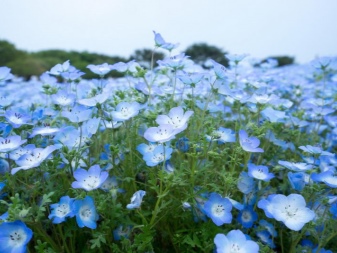
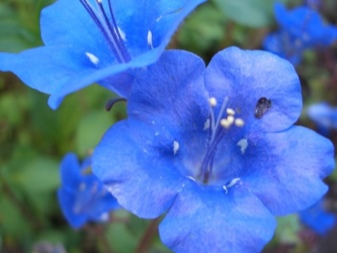
Overview of species and popular varieties
The genus nemophila has 13 species, of which two are the most popular on the territory of our country - this is the nemophila spotted (from the Latin Nemophila maculata) and the nemophila Menzis (from the Latin Nemophila menziesii). Both varieties are very undemanding plants and are well suited for beginners.
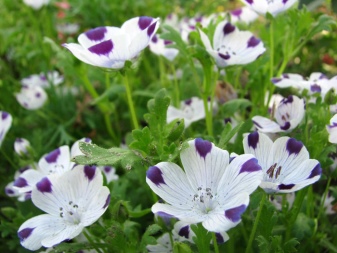
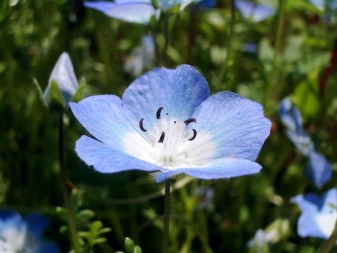
Nemophila spotted
The species is represented by annual plants and is characterized by beautiful white flowers, on each petal of which there is a speck and veins of dark blue or purple flowers. In their shape, they resemble a round bowl, which only enhances the decorative effect of the flower. The species is distinguished by beautiful openwork leaves and is considered low. The height of adult specimens rarely exceeds 25 cm and is generally between 15-20 cm. Spotted nemophila has a very long flowering period, lasting from early June to late September.
The advantage of the species is good frost resistance, which allows planting seeds in warm regions in autumn. After overwintering and going through the process of natural stratification, nemophila seeds emerge very early and bloom in spring. Another feature of the variety is the ability of the bushes to grow strongly, which is why it is not recommended to plant them closer than 20 cm from each other. Due to the relative short stature of most varieties, the species is well suited for balconies, terraces, curbs and rocky gardens.
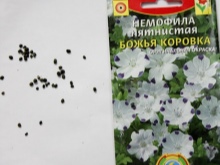
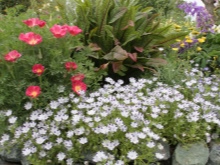
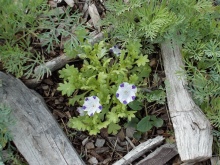
Among the negative properties of spotted nemophila, one can note the tendency to rot when planting too tightly. The most popular varieties of the species are "Ladybug" and "Barbara". The first blooms with beautiful white flowers reaching a diameter of 4.5 cm. Each petal has subtle purple streaks and symmetrical spots. The second is characterized by specks of lilac color and the same veins.
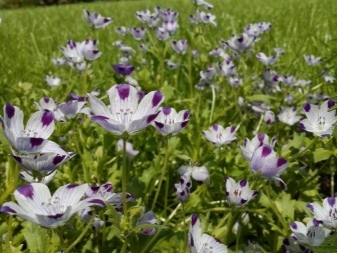
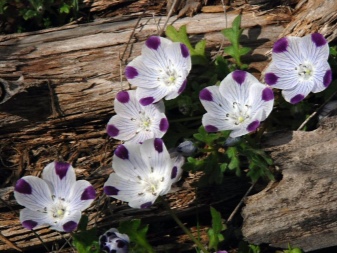
Nemophila Menzisa
This type of American forget-me-nots is characterized by slender, creeping shoots and small pubescent leaves. The flowers have rich shades, and their petals are edged with a contrasting border. The species cannot boast of large flowers; in most varieties, they do not grow more than 2-3 cm. The most popular and demanded variety is called "Discoidalis" (lat. Nemophila discoidalis). The flowers of the plant are painted in dark purple, almost black, have a white edging and the middle of the same color.
Disc-shaped "Gothic" is considered to be no less spectacular variety. Plants have black flowers with a white border and a white eye with a diameter of 2.5 cm, recumbent branched stems and beautiful pubescent leaves.


Thanks to the beautiful flowing greenery, Nemophila looks great not only in the open field, but also in flowerpots.
Landing
There are two ways to plant American forget-me-not. The first is to grow seedlings at home and then transplant them into open ground. The second involves sowing seeds directly into open ground, bypassing the seedling cycle.
Growing from seeds
This method is less labor intensive and allows sowing large areas in a short time. Before you start sowing nemophila seeds, you need to select a site and prepare the soil. Almost all varieties of American forget-me-nots prefer diffused lighting., although on a sunny slope they will feel quite satisfactory. Moreover, according to some gardeners, plants that spend most of the day in the open sun bloom a little longer than their relatives growing in the shade, and the color of their flowers is noticeably brighter.
The next important step is soil preparation. Nemophila is not too demanding on the composition of the soil, however, it feels better on loose and nutritious soils of neutral acidity. If the seeds are planned to be planted in a small flower bed or in a flowerpot, then you can do the preparation of the substrate yourself. For this, turf, humus, fine-grained sand are mixed in equal parts and a little chalk is added to reduce acidity. It is also worth noting that Nemophila does not tolerate dry and poorly permeable soils and, being in such conditions, may simply die. The plant is very fond of wet substrate, which is why it grows in the wild along the banks of reservoirs.


When sowing nemophila seeds in open ground, planting dates must be taken into account. The optimal time for sowing is the first decade of May, provided that the ground has warmed up to 10 degrees, and night frosts are no longer expected.
If the seeds are sown at this time, then the appearance of the first flowers can be expected already at the end of June. If the sowing is extended until July, then the American forget-me-not will begin to bloom not earlier than September. Some gardeners practice autumn sowing, however, the natural stratification of nemophila seeds is appropriate only in regions with a warm climate.

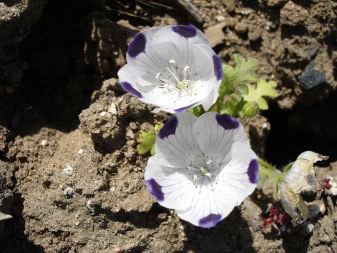
The seed sowing technology is quite simple. For to prevent thickening and planting of a large number of seeds in one place, the seed is mixed with sand... The soil is preliminarily well moistened, the top layer is leveled and grooves are made with a depth of no more than 0.5 cm.To make the rows straight and the flowers easy to distinguish from weeds, experienced gardeners pull a lace, and a groove is already laid along it.
The distance between adjacent rows should not be less than 20 cm, otherwise there is a risk of thickening of the planting: plants begin to stretch upward and lose their decorative effect.Landscape designers recommend planting seeds in batches, at intervals of 2 weeks. This allows plants to enter the flowering phase at different times. After sowing, the soil is spilled well again, trying not to wash the seeds of nemophila to the surface.
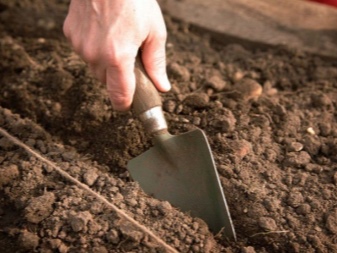
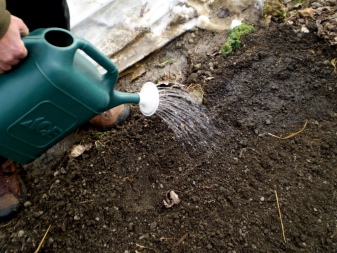
Seedling method
Sowing seeds for seedlings is performed in mid-March. This method is used in cases where it is required to plant not too large spaces, as well as in cold climates and the likelihood of return frosts. The first step is to acquire a suitable container and prepare a soil mixture. Plastic containers with a perforated bottom are well suited as containers for seedlings.
To prepare a nutrient substrate, mix turf, sand and humus in equal proportions, after which the resulting mixture is placed in a well-heated oven for 15 minutes. If the oven was not nearby, then the soil is spilled with boiling water and allowed to cool. Then the substrate is laid out in containers and seeds are planted in it, deepening them no more than 0.5 cm.
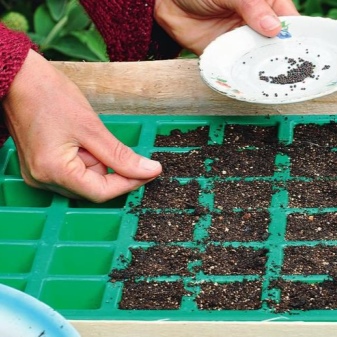
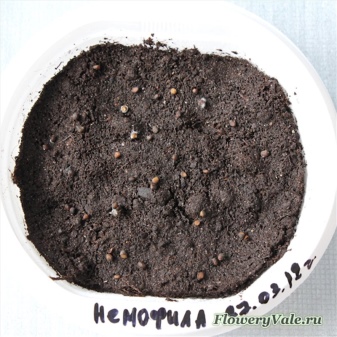
The planting is well moistened from a spray bottle, covered with a film or glass and removed for germination in a warm, bright place. After a couple of weeks, the first shoots appear, which are allowed to grow a little, after which they are necessarily thinned out. If this is not done on time, then the seedling will not have enough space and nutrients necessary for proper growth and development. After the threat of night frosts has passed, and in the daytime the thermometer will not fall below 10 degrees, the sprouts are planted in open ground at a distance of 20-30 cm from each other.
If the heat does not come in any way, and the seedlings have already stretched up to 7 cm, then you can use the peat pots and dive the shoots in them. As soon as the weather is warm, the sprouts are planted in the ground along with the pots. Experienced gardeners recommend to take seedlings outside 10 days before transplanting to a flower bed, gradually increasing the "walk" time from 20 minutes to an hour. On the last night before transplanting, the nemophila containers are left outside, allowing the plants to adapt slightly to nighttime temperatures and thereby reducing the effects of stress on the plants.

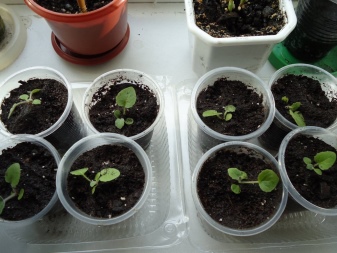

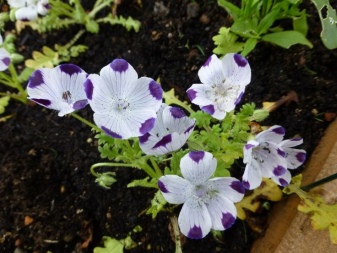
Transplanting seedlings into open ground is carried out in warm, windless weather, preferably in the morning. After planting, the seedlings are well watered and mulched with straw, needles or peat. The first flowers appear 7 weeks after transplanting.
Care
American forget-me-not is very unpretentious in content and does not require the creation of any special conditions. Plant care consists in timely watering, fertilizing and weeding.
Watering
Nemophila loves frequent watering and needs a constantly moist soil. On especially dry days, it is recommended to water the plant in the morning and in the evening, on moderately hot days - only evening watering will be enough. It is advisable to use only warm water, since cold liquid can provoke rotting of the root system. In hot months, nemophila is sprayed from a spray bottle, and this is done either early in the morning or late in the evening.
To avoid rapid evaporation of moisture, it is recommended to mulch tree trunks with sawdust.


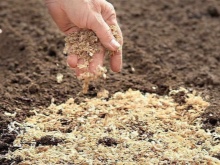
Top dressing
Nemophila grows well in its natural environment and does not need special feeding. In addition, on large areas, which are often occupied by the American forget-me-not, it is very problematic to apply fertilizers. Therefore, when determining a site for nemophila, it is necessary to choose places with fertile land, and use peat rich in useful elements as a mulching material. If the flower grows in a flower bed or in a flowerpot, then just before flowering it can be fed with any mineral fertilizer for flowering plants. A good option would be to use "Zircon" and "Epin".

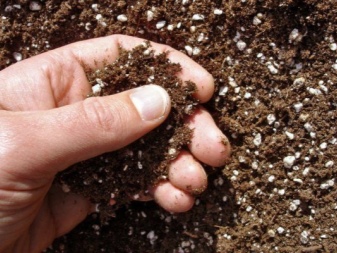
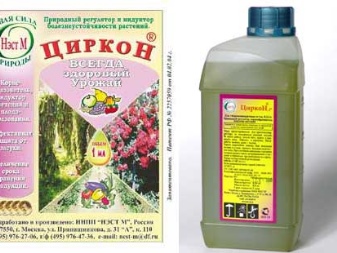
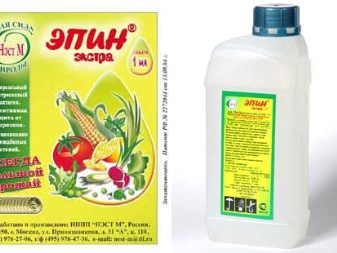
During and after flowering
To increase the flowering time, the nemophila is fed with phosphorus and potassium, and the soil is loosened and weeded. It is impractical to weed large plantations, but garden plants need to be weeded and loosened regularly. These procedures significantly improve the water and air permeability of the soil and preserve the aesthetics of the flower bed. Due to the fact that the American forget-me-not is an annual plant, it does not require any special care after flowering.
If it is decided to collect the seeds, then the boxes are allowed to dry out a little, after which they are carefully collected and placed in a warm, dry place. After 5-7 days, the boxes are carefully opened and the seeds are poured onto a clean sheet. After another 2-3 days, the seed is laid out in paper or fabric bags and stored, not forgetting to indicate the year of collection. Seed germination of nemophila is 3 years. Then they wait for the onset of cold weather, the flower bed is freed from withering plants and dug up for the winter.

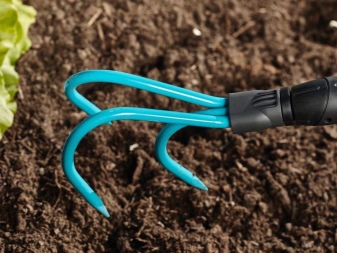
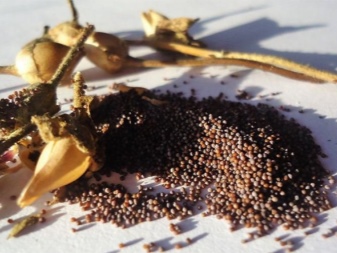

Diseases and pests
American forget-me-not is a sturdy plant and is highly resistant to many flower diseases. The main threat to the flower is the invasion of parasites, which love to feast on its juicy leaves. Great damage to the plant is caused slugs, whitefly, spider mites and aphids. Spider mite does not like high humidity and prefers dry air. Therefore, on hot days, it is necessary to maintain soil moisture, otherwise it will be very difficult to get rid of insects. Acaricides designed to kill ticks show good results.
As for aphids and whiteflies, you can fight them with insecticides such as Fitoverm, Iskra and Aktellik. If American forget-me-not occupies vast territories, then setting traps with beer or sweet syrup would be a more rational way. In garden beds or flowerpots, pests are collected by hand.
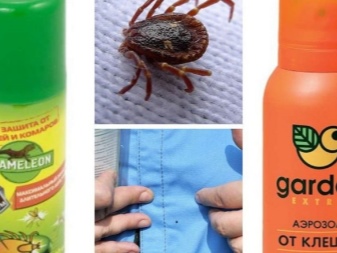

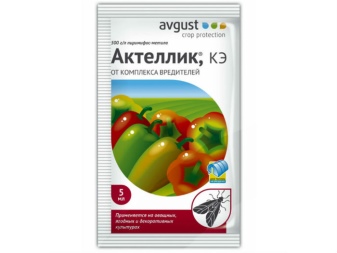

Use in landscape design
Nemophiles are very often used in landscaping areas and look great in the company of simple garden or wildflowers. Against the background of crops such as roses, asters or lilies, American forget-me-nots will not look very impressive and have a chance to get lost. But with bells, iberis, Chinese carnations, gatsania and ursinia, they are in perfect harmony and only emphasize the tenderness and natural aesthetics of flower arrangements. Nemophila is considered a universal element of landscape design and looks good both in single plantings and as one of the members of a floral ensemble.
- American forget-me-not with other garden flowers.

- A carpet of nemophila flowers looks impressive.
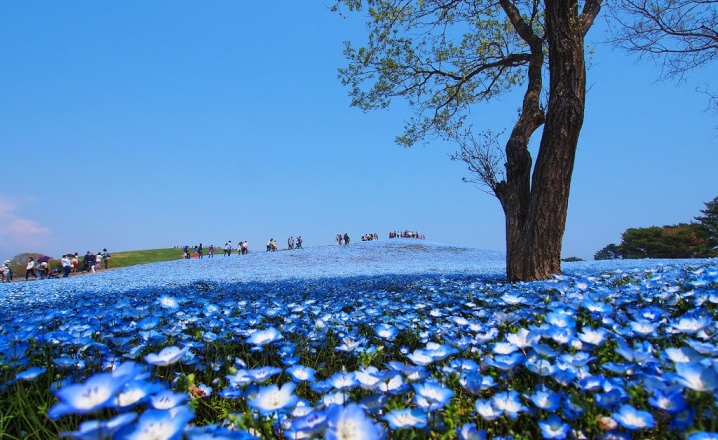
- Thanks to the beautiful combination of rich greenery and delicate flowers, the plant looks great in tall flowerpots and decorative containers.
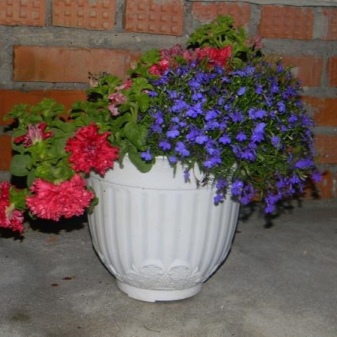
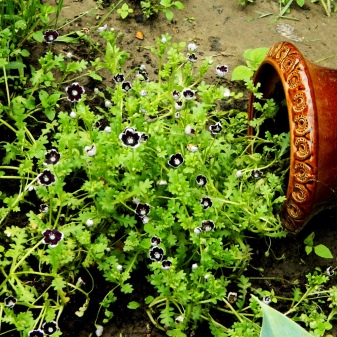
- Nemofila fits perfectly into rock gardens and adds naturalness and natural aesthetics to the composition.
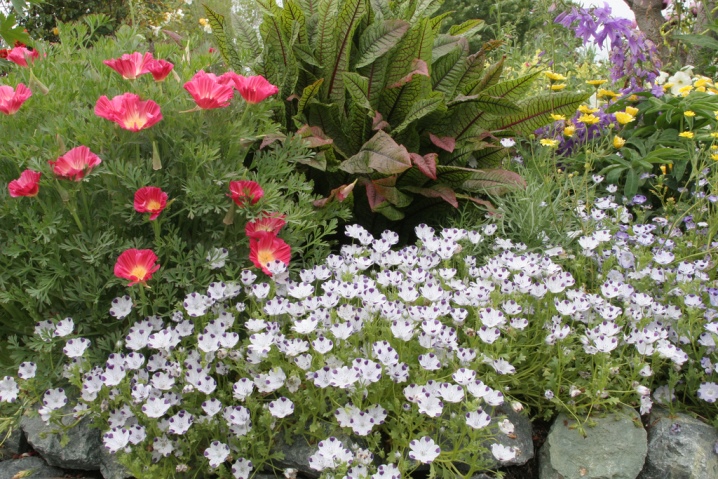
- "Blue-eyed" in the landscape design of the garden, surrounded by garden sculptures.
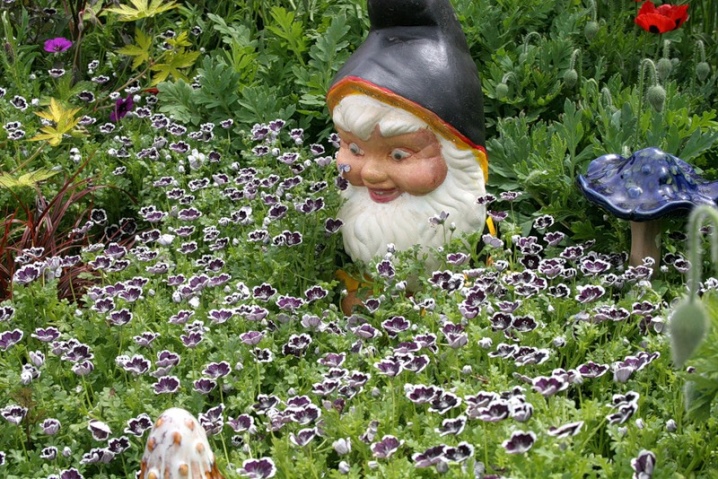
How to grow good nemophila seedlings, see the next video.







































































































The comment was sent successfully.